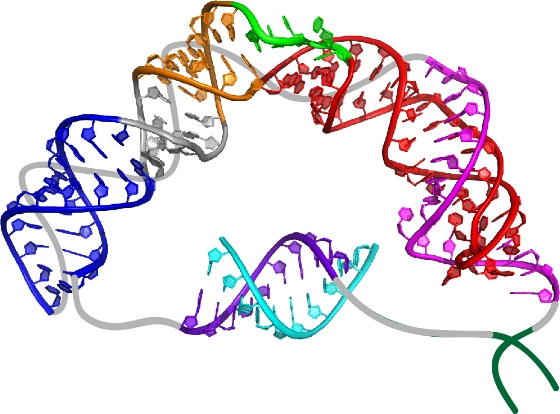Nature:美国科学家新研发一种分子技术分析RNA在活细胞内折叠情
宾夕法尼亚州立大学研究组新研发出一种分子技术,能够更精确预测在活细胞内核糖核酸分子(RNAs)的折叠情况,由此阐明植物以及其他的活体生物对环境条件做出反应的机制。这一研究小组由生物学教授Sarah M. Assmann和化学教授Philip Bevilacqua共同领导。相关文章发表于2013年11月24日的《Nature》杂志上。

Nature:美国科学家新研发一种分子技术分析RNA在活细胞内折叠情况
前言
Assmann 说:“科学家们曾研究过少数的个别RNA分子,而现在我们获得了细胞中几乎所有的、超过1万种不同RNA分子的数据。这是我们首次在全基因组基础上确定植物中的RNA分子的结构,其适用于所有生物。”
温度和干旱等环境压力因素会影响rna分子的结构,由此影响基因的表达方式。
Bevilacqua说:“人们预计,气候变化会导致越来越极端和不可预知的热浪及干旱,从而影响我们的粮食作物,其部分程度上是通过影响粮食作物的RNA分子,由此影响其蛋白质翻译而达到这一效应的。对环境因素影响RNA结构,并由此影响基因表达的机制我们了解得越多,就越有可能利用一些生物技术方法培育或开发出更加耐受这些压力的作物。这些作物能够在更为边缘的条件下更好地生长,有助于养活全球不断增长的人口。”
RNA折叠情况以及这样的折叠调控基因功能的机制探究
研究组在新研究中确定了拟南芥植物中各种rna分子的结构。拟南芥俗称鼠耳芥,研究人员说由于它是首个进行全基因组测序的植物物种,且具有最大数量的可用遗传工具,因此是RNA研究的理想模型。
RNA是所有生物体中DNA与蛋白质之间的中间分子,是基因表达信号通路中的重要元件,基因的表达控制了生物体的功能。不同于双链DNA分子,通过扭曲及环绕蛋白在细胞内压缩。RNA是单链分子,自身进行折叠。研究人员着手解答了这一问题:RNA在细胞中究竟是怎样折叠的以及这样的折叠调控基因功能的机制。
Bevilacqua说:“我们需要一个工具来解答这一问题。这一工具可以将一种化合物导入植物中,改变某些RNA片段但不影响其他部分,随后给出RNA结构的读值。利用这一技术我们可以阐明哪些类型的基因与某些RNA结构性状相关。我们可以尝试了解这些基因结构改变与某些生物学功能的相关性。”
Assmann说:“以往,研究人员会在细胞中逐个地探询个别RNAs的结构,这是一个繁琐的过程。你不能仅通过了解一个或几个RNAs的结构就概括出规律,或是概述RNAs的行为——你无法得到一种模式。现在我们获得了一种特殊生物体的全基因组信息,我们可以开始概括出RNA结构影响基因表达,及最终影响植物功能的模式。其他的科学家们可以探究目的生物体,看可以概括出什么规律。是否存在一些适用于所有生物的、有关RNA结构影响基因表达机制的规律?”
Bevilacqua补充说:“由于RNA在基因调控中发挥着如此重要的作用,我们开发的工具可以供致力于研究所有生物系统的科学家们使用。”
这种方法对于人类健康——例如了解感染引起的发烧有可能如何影响了人类和病原体的RNA结构,具有长期的潜在影响。
原文摘要:
In vivo genome-wide profiling of RNA secondary structure reveals novel regulatory features
Yiliang Ding, Yin Tang, Chun Kit Kwok, Yu Zhang, Philip C. Bevilacqua & Sarah M. Assmann
RNA structure has critical roles in processes ranging from ligand sensing to the regulation of translation, polyadenylation and splicing. However, a lack of genome-wide in vivo RNA structural data has limited our understanding of how RNA structure regulates gene expression in living cells. Here we present a high-throughput, genome-wide in vivo RNA structure probing method, structure-seq, in which dimethyl sulphate methylation of unprotected adenines and cytosines is identified by next-generation sequencing. Application of this method to Arabidopsis thalianaseedlings yielded the first in vivo genome-wide RNA structure map at nucleotide resolution for any organism, with quantitative structural information across more than 10,000 transcripts. Our analysis reveals a three-nucleotide periodic repeat pattern in the structure of coding regions, as well as a less-structured region immediately upstream of the start codon, and shows that these features are strongly correlated with translation efficiency. We also find patterns of strong and weak secondary structure at sites of alternative polyadenylation, as well as strong secondary structure at 5′ splice sites that correlates with unspliced events. Notably, in vivo structures of messenger RNAs annotated for stress responses are poorly predicted in silico, whereas mRNA structures of genes related to cell function maintenance are well predicted. Global comparison of several structural features between these two categories shows that the mRNAs associated with stress responses tend to have more single-strandedness, longer maximal loop length and higher free energy per nucleotide, features that may allow these RNAs to undergo conformational changes in response to environmental conditions. Structure-seq allows the RNA structurome and its biological roles to be interrogated on a genome-wide scale and should be applicable to any organism.

